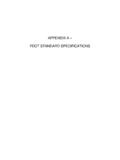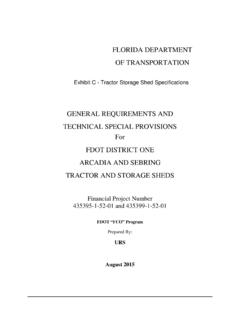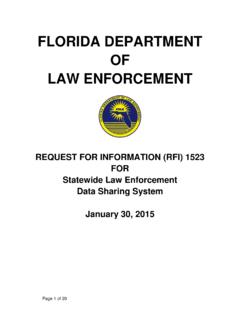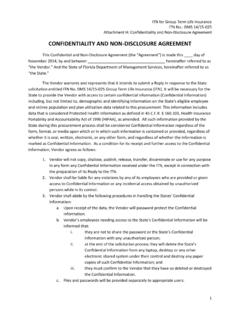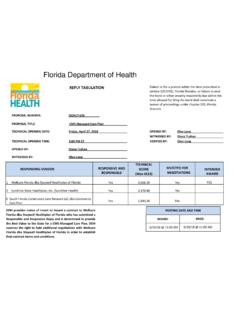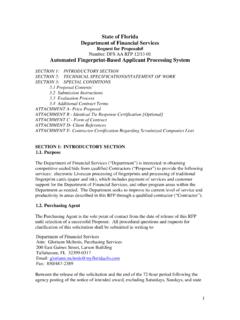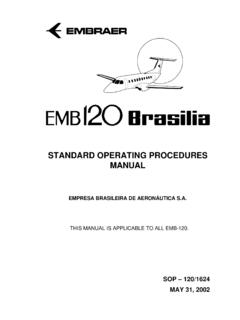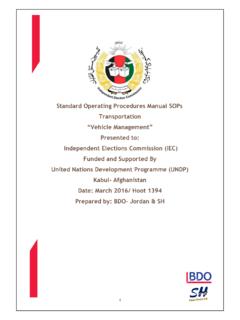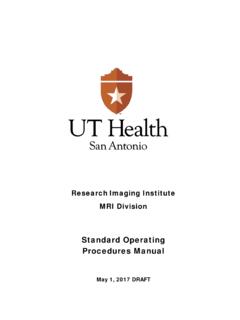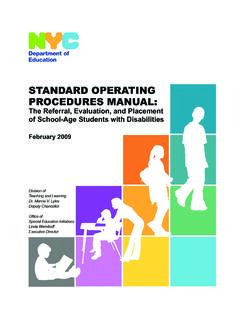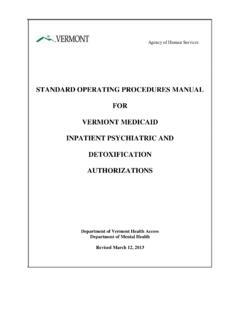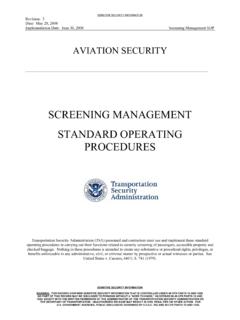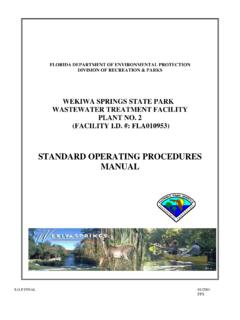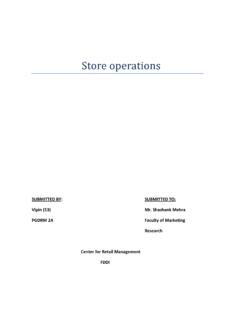Transcription of STANDARD OPERATING PROCEDURES MANUAL - Florida
1 SOP Final 8/2002 FPSFLORIDA DEPARTMENT OF ENVIRONMENTAL PROTECTIONDIVISION OF RECREATION & PARKSBLUE SPRING STATE PARK WASTEWATER TREATMENT FACILITYPLANT (FACILITY #: FLA011279) STANDARD OPERATING PROCEDURESMANUALSOP Final 8/2002 FPSSTANDARD OPERATING PROCEDURES ( ) MANUAL CONTENTSINDEX1. Chapter 1 - Current Permit Renewal Schedule .. Domestic Wastewater Facility Permit .. Operator License ..1-52. Chapter 2 - Site Location Map, Park Plan & Plant Site Location Map .. Park Plan .. Plant Configuration ..2-73. Chapter 3 - Wastewater Treatment Plant Operational Guide ..3-24. Chapter 4 - Flow Calibration Collection / Transmission System (Pump-Down Method) ..4-35. Chapter 5 - Operation, Maintenance & Performance Operation, Maintenance & Performance Inspections .. 4-36. Chapter 6 - Record Custody & Documentation .. of Field Sampling and Equipment .. and Documentation Requirements for Field Operations.
2 And Monitoring Requirements .. and/or Disposition of all Records and Documents ..6-237. Chapter 7 - of Abnormal Events .. of Discharge Monitoring Reports ( ) ..7-68. Chapter 8 - Residuals Residuals Management ..8-3 SOP Final 8/2002 FPSSTANDARD OPERATING PROCEDURES ( ) MANUAL CONTENTSINDEX - Continued9. Chapter 9 - RPZ Checks .. Flow Meters ..9-510. Chapter 10 - Other Equipment pH Meters .. Residuals Chlorine Meters .. Calibration Documentation ..10-8 SOP Final 8/2002 FPSCh. 1 Pg. 1 SOP Final 8/2002 FPSCh. 1 Pg. 2 STANDARD OPERATING ProceduresManualCurrent PermitsChapter 1 SOP Final 8/2002 FPSCh. 1 Pg. 3 Current PermitsSection Wastewater FacilitiesPermitSOP Final 8/2002 FPSCh. 1 Pg. Permit Renewal ScheduleBLUE SPRING State Park # 1 WWTPF acilities # FLA011279 Issue Date: July 18, Selection: June 15, Application Documents Preparation (Begin): 9/15/ Submittal Date: January 15 Expiration Date: July 15, 2006 SOP Final 8/2002 FPSCh.
3 1 Pg. Current PermitSOP Final 8/2002 FPSCh. 1 Pg. - Operator s LicenseJONES, JOE ANNW astewater License C- 77933301 11TH STREETELKTON FL32033 SOP Final 8/2002 FPSCh. 1 Pg. 1 STANDARD OPERATING ProceduresManualSite Location Map, Park Plan &Plant ConfigurationChapter 2 SOP Final 8/2002 FPSCh. 2 Pg. 2 SOP Final 8/2002 FPSCh. 2 Pg. 3 Site Location Map, Park Plan &Plant ConfigurationSection Location MapSOP Final 8/2002 FPSCh. 2 Pg. 4 SOP Final 8/2002 FPSCh. 2 Pg. 5 Site Location Map, Park Plan &Plant ConfigurationSection Plan SOP Final 8/2002 FPSCh. 2 Pg. 6 Park PlanSOP Final 8/2002 FPSCh. 2 Pg. 7 Site Location Map, Park Plan &Plant ConfigurationSection Configuration SOP Final 8/2002 FPSCh. 2 Pg. 8 SOP Final 8/2002 FPSCh.
4 2 Pg. 1 STANDARD OPERATING ProceduresManualWWTP Operational GuideChapter 3 SOP Final 8/2002 FPSCh. 3 Pg. 2 SOP Final 8/2002 FPSCh. 3 Pg. 3 SOP Final 8/2002 FPSCh. 3 Pg. 4 WWTP Operational GuideSection GuideSOP Final 8/2002 FPSCh. 3 Pg. 5 OPERATIONAL GUIDEFORUTILIZINGEXTENDED AERATION ACTIVATED SLUDGE - INTRODUCTIONThe ownership and operation of a sewage system is a large responsibility. Through proper operation, thelocal ecology of the area will be safe-guarded and the health and welfare of the residents in the area will begreatly protected. This Modular Sewage Treatment Plant has been approved and permitted by the FloridaDepartment of Environmental Protection (FDEP) - Domestic Wastewater Section, with permitting authority delegated to the BLUE SPRING County Environmental Protection Commission (EPC). When operated properlyand maintained as provided by the manufacturer, the plant is designed by the Engineer of Record , to fit specificrule and permitting requirements.
5 Proper operation of the Sewage Treatment Plant assures the sanitary health andwelfare of the area you serve. This will remain true when properly operated and maintained and as long as theplant is used for the design treatment loading. No other contributing wastewater flows should be introduced intothe plant for treatment, nor should plant modifications be made to it s design and operation without approval andauthorization by the Owner and FDEP/EPC - Domestic Wastewater - PURPOSE & GENERAL :This Operational Guide is intended to describe Sewage Treatment Operation, Plant Start-Up PROCEDURES ,and Operation Testing and Maintenance to enable you to adequately provide sewage treatment for a long periodof time with minimum operation and maintenance INFORMATION:Sewage or waste water is a combination of bodily waste and the domestic waste from park residences,business buildings, institutions, and establishments with ground surface and or storm water as may find its wayinto the Sewage Collecting Sewage contents are generally a combination of liquids and solids.
6 Usuallythe solids are less than and are made up of inorganic and organic matter. The solids themselves are alsoclassified as dissolved and suspended solids. Approximately 1/3 of the solids are in a suspended state and theremaining 2/3 are in bacteria types are commonly found in sewage. These include (1) pathogenic, (2) anaerobic, (3)aerobic;1. The pathogenic class of bacteria causes or is capable of causing disease-- such as typhoid fever,dysentery, diarrhea, etc. Those bacteria may spread disease and contaminate the area throughunderground and surface water supply bacteria is a microorganism that thrives where oxygen is not available. They performfunctions in the digestion and reduction of bacteria requires free oxygen and is necessary for the nitrification and oxidation processes inthe treatment of is responsible for the decomposition processes; when properly used and controlled, they producethe desired results in the treatment of - SEWAGE TREATMENT PROCESSES, PLANT STAGES & FLOW TREATMENT PROCESSES:In general sewage treatment processes are classified in stages or the degree of treatment afforded.
7 Theprinciple stages or degrees of treatment are: SOP Final 8/2002 FPSCh. 3 Pg. 6(1)Primary and Preliminary Treatment: Typical unit processes include screening, flow equalization, andprimary settling. When all unit processes are used , this type of treatment removes up to 50% of thesuspended solids and 25 to 35% of the Biochemical Oxygen Demand ( ). (2)Secondary with Clarification: Typical Unit Processes include aeration and settling tankage. Supplementing primary treatment, this aerobic process removes up to 90% of the suspended solids (3)Nutrient Removal: Typical components include an anoxic tank located either in front or in between theaeration tankage for nitrate-nitrogen reduction, and either an anaerobic tank or chemical feed system forphosphorus reduction when required.(4) Filtering (Tertiary) System supplements the first two stages of treatment by removing up to 95% of thesuspended solids and through a physical filtering action.
8 Typical unit processes include filters, filterdosing system, and filter backwashing Blue spring State Park Sewage Treatment Plant is designed to provide preliminary treatment viabar screening, and secondary treatment with flow equalization, aeration, dual final settling tanks, dual chlorinecontact tanks, and sludge STAGES & FLOW SEQUENCE PLANT STAGES:The Modular Sewage Treatment Plant provides the following stages of sewage treatment: Figure No. 1 Flow Diagram of the Modular Sewage Treatment PlantA. Influent Pump Station (located near the original historic WWTF site)B. Aeration Tank C. Flow Equalization Sewage Holding Tank D. Final Settling TankE. Sludge Digester F. Chlorine Contact TankG. Effluent DisposalSECTION - SETTINGS & OPERATION OF & OPERATION OF EQUIPMENTSOP Final 8/2002 FPSCh. 3 Pg. 7 The proper setting and operation of equipment will assist in obtaining treatment efficiency for thewastewater treatment facilities and provide acceptable effluent limits.
9 It is important for the Plant Operator to seta regimen for equipment operation and make the necessary adjustments to obtain OPERATING efficiency. Thefollowing operational sequences are intended to help the Plant Operator set and operate equipment of variousplant components. OPERATIONAL SEQUENCE:A. Influent Pump StationThe raw sewage is received in the influent pump station. This station is located at the site of the originalBlue Springs WWTF near the St John s River. Collected wastewater is discharged through a 3" force main tothe flow equalization tank after passing through a bar screen. This pumping operation is automatic and is doneby using electric driven submersible pumps. These pumps are of the grinder type. The pumps are controlled byfour (4) mercury float switches either automatically or manually with the hand on/off switches. This pump stationcollects sewage flows from the entire park.. The float conditions have been set as follows: Float #1 the low level float, turns both pumps off.
10 Float#2 activates the lead pump. If water level would continues to rise from an unusual flow while the lead pump isrunning, then Float #3 activates lag pump. Float #4 activates the red signal light and audible alarm in a highwater condition. A alternator inside the control panel alternates lead / lag pumps each tine they are shut off. Eachpump also has a run light and elapsed time meter at the panel to show when the pump is in use and it s run float switch liquid levels are established in the influent pump station to determine the PUMP ON,PUMP OFF, and the HIGH WATER POSITIONS within the wet basic components in this automatic and manually operated system include but is not limited to: Floatswitches, float stem with guides, alternator, elapsed time meters, over-load reset switch over-load circuit breakers,holding relay, red signal light, audible alarm and OPERATING the pump station, the Float switch #2 rises to the PUMP ON POSITION, the alternatoractivates pump No.
